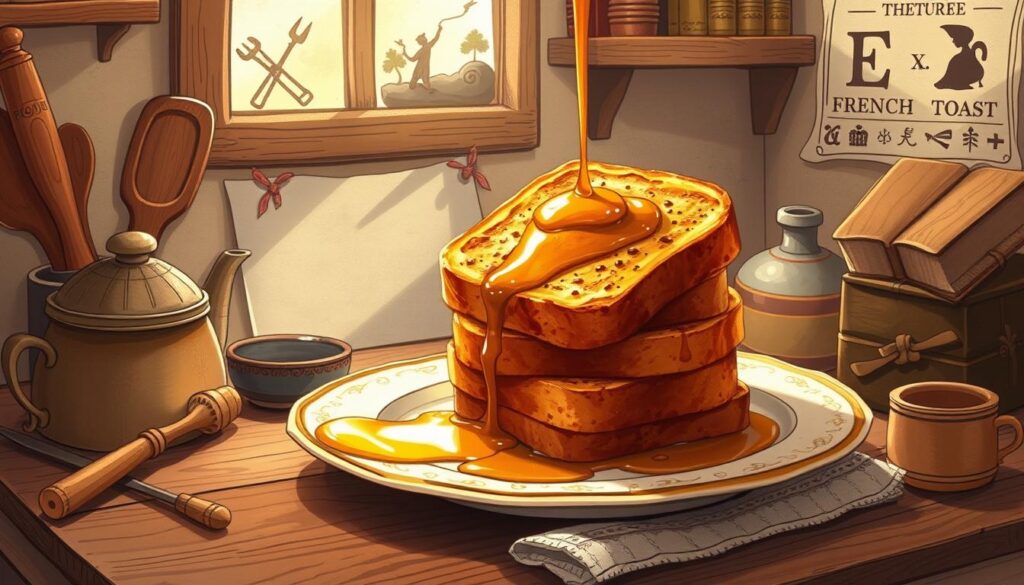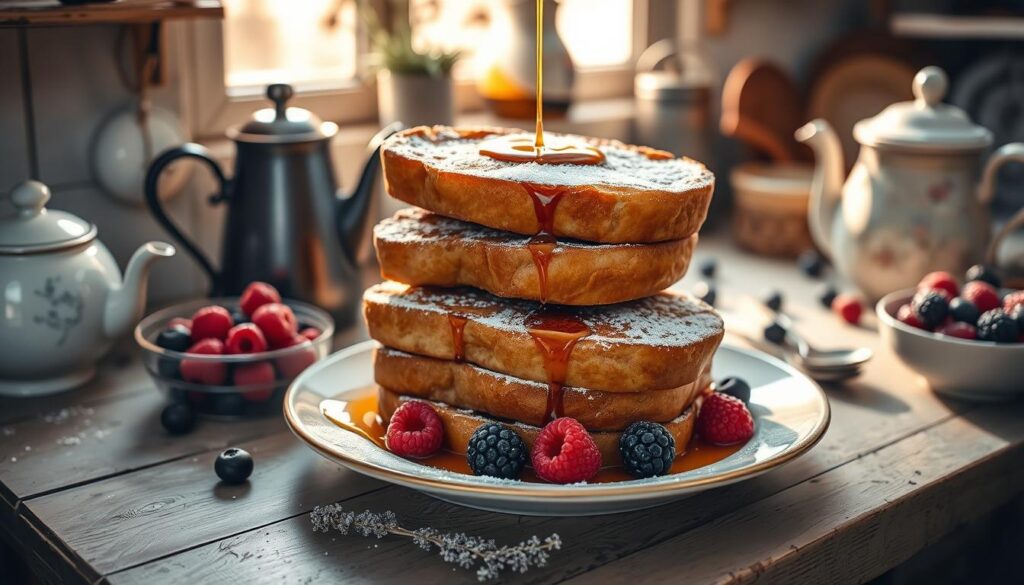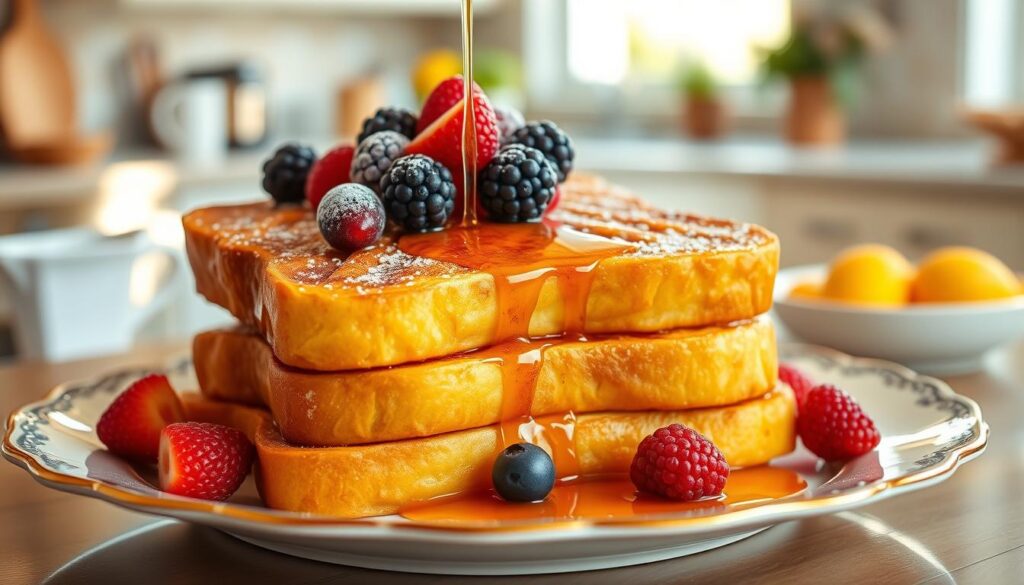I’m excited to share the tasty journey of French toast. It’s a story that goes back to ancient Rome and has grown to be loved worldwide. This tale shows how flavors and traditions have made French toast a favorite for breakfast.
In this article, we’ll look at the important moments and cultural influences that shaped French toast. We’ll explore its origins, its name, and how it became a gourmet treat. It’s a story of how a simple dish became a global favorite.
Key Takeaways
- Discover the ancient Roman origins of French toast, tracing its roots to a dish called “pan dulcis”.
- Explore the cultural influences that shaped the evolution of French toast, from its links to medieval European cuisines to its modern-day global adaptations.
- Unravel the linguistic mysteries behind the name “French toast,” delving into the historical context and regional variations.
- Understand the remarkable transformation of French toast, from a humble peasant dish to a beloved gourmet indulgence.
- Appreciate the enduring allure of French toast and its status as a culinary ambassador that has transcended borders and delighted palates worldwide.
Unveiling the Mouthwatering Origins of French Toast
To explore the history of French toast, we start a journey through time. This dish’s roots go back to ancient times. In the Roman Empire, cooks created early versions of French toast.
Tracing the Roots of a Beloved Breakfast Classic
The first French toast-like dish was pan dulcis. It was made by soaking bread in milk and eggs, then frying it. This ancient recipe was the start of French toast’s journey.
Uncovering the Culinary Heritage Behind French Toast
Over time, the recipe for French toast changed. Each place added its own twist. From medieval Europe’s poor knights’ pudding to France’s pain perdu, French toast’s history is rich.
| Historical Precursor | Region | Key Ingredients |
|---|---|---|
| Pan dulcis | Roman Empire | Bread, milk, eggs |
| Poor knights’ pudding | Medieval Europe | Bread, milk, eggs, sugar |
| Pain perdu | Renaissance France | Bread, milk, eggs, butter |
Exploring French toast’s origins reveals a story of creativity and cultural exchange. This journey shows how it became a favorite breakfast dish.
french toast origin: A Journey Through Time and Taste
The story of french toast is a long and tasty one. It goes back centuries, mixing history and flavors from around the world. It all started in ancient Rome, where cooks turned old bread into a sweet treat.
As it traveled through medieval Europe, french toast changed with each place it visited. In France, it was called “pain perdu” or “lost bread.” In England, it was “poor knights’ pudding,” showing its simple beginnings.
The tale of french toast origin is one of creativity and making do. It has seen many kitchens, from Italy in the Renaissance to America in the 19th century. french toast beginnings are all about using what you have and making it special.
“The true beauty of french toast lies in its ability to transform the most ordinary of ingredients into an extraordinary culinary experience.”
Today, the roots of french toast still inspire cooks. They try new things with this classic dish. Whether it’s with maple syrup, powdered sugar, or fresh fruit, french toast brings people together.

| Region | Traditional Name | Notable Characteristics |
|---|---|---|
| Ancient Rome | Pan Dulcis | Stale bread soaked in milk and eggs, then fried |
| Medieval Europe | Pain Perdu (France) Poor Knights’ Pudding (England) |
Repurposed stale bread, often sweetened |
| Renaissance Italy | Fritelle | Bread dipped in egg and fried, sometimes flavored with spices |
| 19th Century America | French Toast | Emerged as a popular breakfast dish, with a focus on sweetness and indulgence |
The Ancient Beginnings of Bread-Based Delights
The story of French toast starts with the ancient Romans. They soaked bread in a mix of milk and eggs before frying it. This early dish, called pan dulcis, is a key part of French toast’s history.
As the Roman Empire grew, so did the dish. It traveled to new places, where local tastes and traditions shaped it. This journey helped create the French toast we love today.
Exploring the Earliest Known Predecessors
But pan dulcis wasn’t the only ancient dish like French toast. Medieval Europe had poor knights’ pudding, made with milk, eggs, and sugar-soaked bread. It was fried to perfection.
- The ancient Egyptians enjoyed armesan, bread soaked in milk and then fried.
- In ancient Greece, a dish called French toast was made by dipping bread in a milk and egg mixture, then frying it.
- Even in ancient China, a dish called ruan bing was made by soaking bread in a custard-like mixture before cooking it.
These ancient dishes were the start of French toast. Over time, as cooking styles mixed, the French toast etymology grew. It became a beloved part of global food history.
Traversing Europe’s Influence on French Toast Evolution
French toast traveled through Europe, meeting many regional traditions. In the medieval times, it was called “poor knights’ pudding” or “German toast.” This shows how cooks turned stale bread into a special dish.
As time went on, each European area added its own twist to French toast. Spain’s version had cinnamon, while England’s had nutmeg. These changes made the french toast history and french toast genesis richer. The french toast provenance grew more diverse.
“French toast has a captivating history that is woven into the culinary tapestry of Europe, each region contributing its own unique flair to this beloved breakfast classic.”

Over the years, French toast went from a way to use up old bread to a favorite dish. It shows the creativity and resourcefulness of Europe’s cooks. The dish’s journey is a story of how different traditions and tastes came together, creating the french toast history we love today.
The Remarkable Transformation of Humble Ingredients
The story of french toast starts with old cooking traditions. Back then, cooks used stale bread in creative ways. This simple trick to avoid waste turned into a favorite breakfast dish.
The journey of french toast shows the creativity of cooks over time. They added cream, sugar, and spices to make it richer. This turned the dish into a sweet treat loved by many in Europe.
From Stale Bread to Exquisite Indulgence
The french toast origin is a tale of culinary growth. What started as a way to use up stale bread became a luxurious dish. Richer ingredients made it a special treat for breakfast.
“The transformation of French toast from a utilitarian dish to a decadent indulgence is a true testament to the ingenuity of cooks throughout the ages.”
As cooking styles changed, french toast got even more interesting. Each place and culture put their own spin on it. This made french toast a favorite breakfast for people everywhere.
Decoding the Intriguing Etymology of “French Toast”
The name “French toast” has a mysterious past. It’s believed to have started in the United States in the 17th or 18th century. But what’s the story behind this favorite breakfast dish?
Unveiling the Linguistic Mysteries Behind the Name
Many think “French toast” came from France, where similar dishes were loved for centuries. Others believe it was named after French cooking styles that spread across Europe. These styles influenced how the dish was made and served.
The french toast etymology might also tie to its other names, like “German toast” or “Spanish toast.” These names show the dish’s popularity and the cultural exchanges that shaped it over time.
“The name ‘French toast’ is a culinary enigma, with layers of history and cultural influences woven into its very essence.”
The french toast backstory tells a story of culinary creativity and lasting appeal. From ancient times to today, “French toast” shows the beauty of global cooking traditions.

Regional Variations and Cultural Twists
The tasty french toast has traveled far, picking up many regional flavors and traditions. Each version shows off the local tastes and customs, proving its lasting charm. From Spain’s cinnamon to the American South’s vanilla, french toast delights everyone.
In Portugal, “Rabanadas” is a special take on french toast. It’s made with milk, eggs, and cinnamon, then fried until golden. This dish honors french toast’s roots while adding a Portuguese twist.
In the United States, french toast gets its own special touches. The South adds vanilla for a sweet aroma. The Midwest might top it with powdered sugar or maple syrup, showing its french toast’s history as a breakfast favorite.
French toast is a true culinary chameleon, fitting into many cultures. Its ability to mix with different tastes and traditions has made it a global favorite.
“French toast is a canvas upon which cultures can paint their own unique culinary masterpieces.”
French Toast: A Culinary Ambassador Across Continents
The global spread of french toast shows its lasting charm. It proves that food can cross cultural lines. As it traveled, it picked up new twists, showing the creativity of cooks worldwide.
In North America, it’s fluffy and sweet. In the Middle East, it’s cheesy and savory. French toast has become a bridge between different food traditions. It’s a dish that celebrates local tastes and history.
Exploring Global Interpretations and Adaptations
In Paris, you’ll find pain perdu, a nod to its French roots. In Portugal and Spain, rabanadas and torrijas add their own flavors, like cinnamon and citrus.
In the Middle East, frunj mixes French toast with local tastes. It includes rosewater, pistachios, and cheese. Japan’s furenchi-torasuto is fluffy and custard-like, with a crunchy outside.
These versions of french toast show its global appeal. They prove that simple ingredients can become something special.

“Food, like language, is a powerful means of communication and connection. The evolution of french toast across cultures is a testament to its ability to bridge divides and bring people together.”
Delving into the Art of French Toast Mastery
Making perfect french toast is a mix of skill and creativity. Choosing the right bread and timing the frying are key. Over the years, cooking techniques have made french toast a true art, loved by many.
The secret to great french toast is knowing your ingredients. The bread you pick can change everything. Brioche or challah add luxury, while sourdough or Italian bread bring a savory taste.
The batter, made from eggs, milk, and spices, is crucial. Whisking it well ensures flavors are evenly spread. Frying it just right gives a golden outside and a soft inside.
“The true artistry of french toast lies in the delicate balance of flavors and textures, elevating a humble dish into a culinary masterpiece.”
Chefs are always trying new things with french toast. They add unique flavors and creative touches. This keeps the dish exciting and fresh.
French toast is perfect for a weekend brunch or a cozy treat any time. It’s a dish that keeps inspiring and delighting us. By combining tradition with creativity, it remains a beloved classic.

The Evolution of French Toast: From Humble Treat to Gourmet Delight
The story of french toast is fascinating. It went from a simple dish to a gourmet favorite. This change happened over time, with new ingredients and flavors added along the way.
Tracing the Culinary Journey of a Beloved Classic
The genesis of french toast started with ancient cooks. They used stale bread, eggs, and milk to make a tasty meal. This simple dish evolved, influenced by different cultures and times.
In the Middle Ages, it was called “pain perdu” or “lost bread.” It became popular for using up old bread. Cooks added sugar, cinnamon, and spices, hinting at its future as a rich treat.
The 19th century brought French toast more fame. Chefs used richer ingredients and fancy ways to serve it. It was topped with fruit, whipped cream, and maple syrup, making it a favorite.

Now, french toast keeps evolving. Chefs and home cooks are getting creative. They make it with smoked salmon, avocado, or sweet spices, showing its endless possibilities.
The love for french toast shows it can please many. It crosses cultural lines and delights food lovers. As we enjoy its rich history, we wonder what new forms it will take.
Celebrating the Enduring Allure of French Toast
The history of french toast is long and rich. Yet, its charm remains strong. This dish brings back memories of comfort and joy. It’s a favorite for many, enjoyed at any time.
French toast is loved for its flexibility. It suits many tastes and traditions. It turns simple bread into a delicious treat, showing the creativity of cooks.
The story of french toast shows how people adapt and grow. As cultures change, so does how we enjoy this dish. Its history is a mix of old and new, a story of discovery and innovation.
“French toast is not just a meal, it’s a moment of pure indulgence – a chance to savor the comforting flavors and textures that have delighted palates for centuries.”
Today, french toast still sparks creativity and nostalgia. It’s enjoyed with many toppings, loved by all ages. Its lasting appeal shows the power of turning simple things into something special.

| Key Attributes of French Toast’s Enduring Allure | Significance |
|---|---|
| Nostalgia and Comfort | French toast evokes a sense of warmth and familiarity, connecting us to cherished memories and moments of connection. |
| Versatility and Adaptability | The dish’s ability to be prepared in diverse ways and pair with a variety of toppings and accompaniments ensures its universal appeal. |
| Culinary Heritage and Innovation | The rich history and evolution of french toast, from humble beginnings to gourmet delights, captivates food enthusiasts. |
| Timeless Indulgence | Whether enjoyed as a leisurely breakfast or an any-time treat, french toast remains a timeless source of pure gastronomic pleasure. |
French Toast: A Timeless Indulgence for All Ages
The love for where did french toast come from knows no bounds. It’s a dish that brings joy to people of all ages. From sweet childhood memories to gourmet delights, french toast beginnings has touched hearts worldwide.
Exploring the Universal Appeal of This Delectable Dish
The story of the roots of french toast goes back to ancient times. It started as a simple bread dish. Today, it’s loved in many ways, from classic to gourmet.
So, why do people love French toast so much? It’s the comfort, the memories, and the indulgent taste. French toast is more than a meal; it’s a timeless classic that brings people together.

“French toast is not just a dish, it’s a culinary canvas that allows for endless creativity and personal expression.”
In cities like New York and Paris, French toast is a favorite. It’s enjoyed by everyone, from young to old. Its journey from simple beginnings to gourmet delight has made it a beloved dish.
Conclusion: Savoring the Rich Legacy of French Toast
Exploring the history of French toast has left us with a deep love for this breakfast favorite. It has roots in ancient Rome and has evolved into today’s gourmet delights. This journey shows how food can connect us across time and cultures, creating lasting memories.
The story of french toast begins with ancient cooks turning simple ingredients into tasty treats. As it spread through Europe, it picked up local flavors and traditions. Now, it’s a dish loved worldwide for its rich taste and history.
The history of french toast is a mix of tradition and creativity. It’s a tale of how a simple dish became a global favorite. From its name to its many versions, French toast shows the power of food to unite us all.
FAQ
What are the origins of French toast?
French toast’s roots go back to ancient Rome. Cooks there soaked bread in milk and eggs before frying it. This early version, called pan dulcis, started the journey to today’s French toast.
How did French toast spread throughout Europe?
As the Roman Empire grew, so did French toast. It reached different areas, where local tastes and traditions shaped it. In medieval Europe, it was known as “poor knights’ pudding” or “German toast.”
Each region added its own twist, like cinnamon in Spain or nutmeg in England.
What is the origin of the term “French toast”?
The name “French toast” is a mystery. It likely came to the US in the 17th or 18th century. Some think it was because of France’s love for it. Others believe it honored French cooking traditions in Europe.
How has French toast evolved over time?
French toast went from a simple dish to a favorite treat. Cooks added cream, sugar, and spices, making it richer. This turned it into a luxurious breakfast that people love worldwide.
How has French toast been interpreted globally?
French toast has many versions worldwide. In Spain, it’s cinnamon-flavored, while in the American South, it’s vanilla-scented. Each version shows off local tastes and traditions.
What is the enduring appeal of French toast?
French toast brings back memories of comfort and indulgence. It’s perfect for a weekend breakfast or a quick treat. Its ability to connect us to happy times makes it a beloved dish globally.

 Chef Julian Moreau
Chef Julian Moreau
